Alleppey: Learn
The
Context
After hearing about the luxury
houseboats and for my abhorrence of the same, I had almost made up
my mind to skip Alleppey – Can you believe it! But thanks to the
snake boat races, which were happening everywhere in and around
Alleppey during the Onam celebration week, I headed for Alleppey.
Alleppey, Kumarakom, and Kollam are hubs of backwater cruising, but
the backwaters don’t start and end with luxury cruises. There is a
whole different world out there extending from Kochi to Kollam. I
had my share of luxury in a Shikara cruise in Vaikom
backwaters near Kochi itself, which I have discussed elsewhere. Now
my only motivation for Alleppey was discovery of a new different
life waiting to be explored in backwaters.
Alleppey is the central hub of waterways opening up
to the widest stretch of Vembanad Lake near Nehru Trophy Boat Race
finishing point. I snuggled myself up in a comfortable home stay
next to the finishing point for almost a week and explored the
backwaters like a local (except that I had no knowledge of
Malayalam). I think this is the only way to spend more than 2 days
in backwaters: whatever your appetite for luxury, you just can’t
keep ordering people days-after-days, weeks-after-weeks, sitting in
a luxury bedroom inside a houseboat, knowing well enough your
houseboat is destroying the beautiful environment outside with the
ugly snort of diesel.
Life in Backwaters
The life in the backwaters
intersperses with that on the land, but indeed there are a few
villages which have no land connection with the outside world. The
backwaters are the canals and lakes created by the backflow of sea
water into the rivers arriving from the Nilgiris for exit into the
sea via lagoons created next to the sea by deposition of eroded
soil. This flow of water, sweet n' salty, is the lifeline of the
people in the villages next to the backwaters. They fish and farm
in the water and export the produce to the outside world through
numerous boats of varying sizes extending from small toady boats to
large snake boats, interestingly used traditionally for
transportation of soldiers. Some row them leisurely with raw muscle
power, yet others have installed automatic motors pushed by diesel.
The government has also chipped in with their large size ferries
connecting the main centers with the small island villages in the
backwaters. I explored the backwaters in the government run ferries
as well as a small country boat.
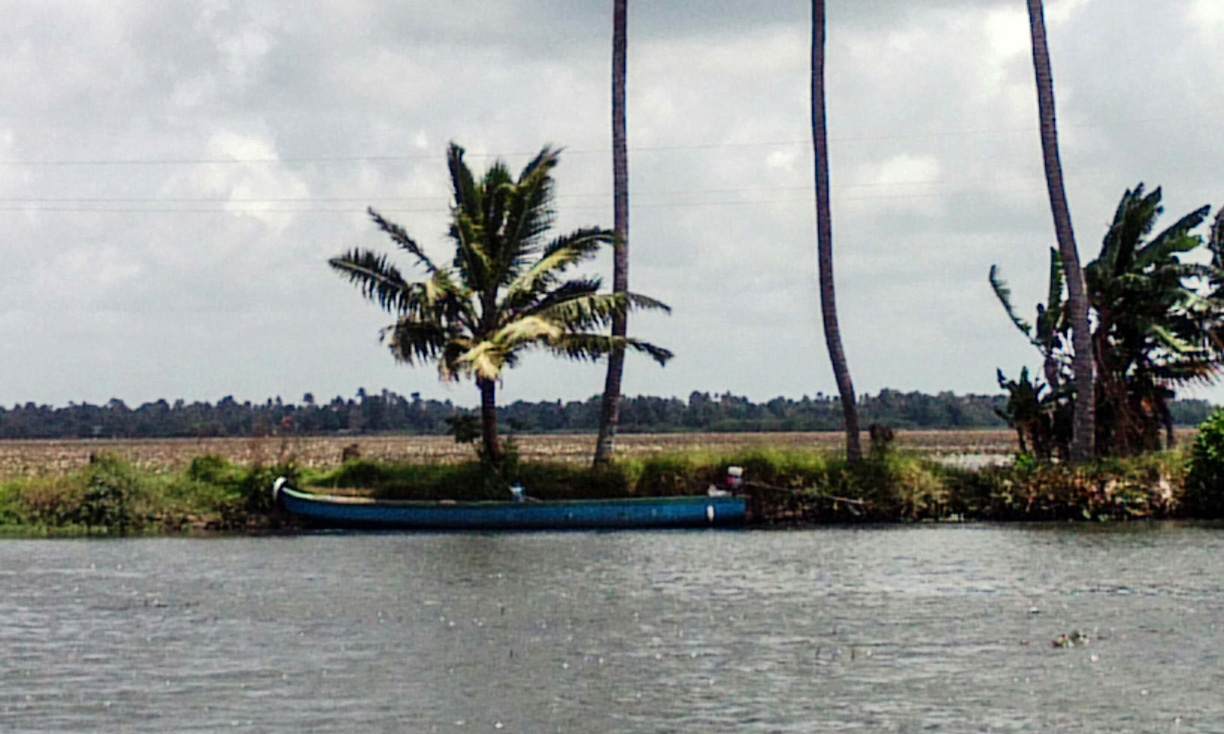
The ferry cruise connecting Alleppey to Kottayam is
around a four hrs journey connecting dozens of villages en
route. I boarded the ferry and tried looking as local-like as
possible, but the long stay in Delhi has made me whiter, if not
fairer, than most of them living in the villages, for which color
the Keralites seem to be having a liking; so, each village would
greet me with hand waves, which, after a while, my hands would
respond in a sort of reflex action without any intervention of mind
whatsoever. But, unfortunately, that also made me an alien,
disconnecting me from the secrets of the backwaters lives. So,
whatever I gathered is from my observation of the village life from
a distance, which I did try to compensate later be taking a guided
tour in a country boat but with moderate success only.
The villages located next to the backwaters were
completely dependant upon ferry for travel. The houses were located
next to the shore, and on the rear side were paddy fields. The
ordinary schools and doctors were available in the villages itself,
but most of the people owned small boats called toddy boats for
emergency travel to the cities. There were also restaurants on the
shores, which seemed to be catering to the leisure class. The
people would wash laundry, utensils, themselves, in the backwaters,
and would generally idle away time next to the waters.
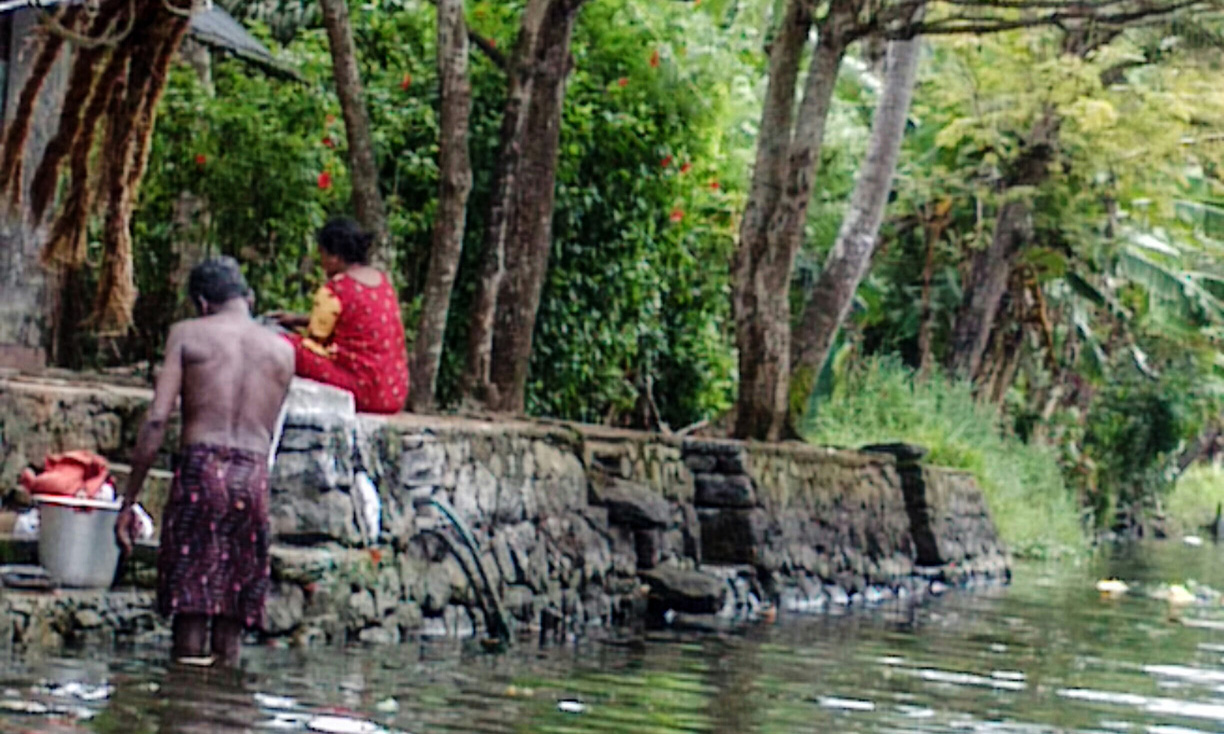
Though the travel to and fro the local landmarks like
churches/mosques/temples, neighborhood attractions, public
services, etc, would happen in small country boats or bigger
privately owned for-hire boats, the arrival of the government
ferry, which would just be only a few times a day, would be an
event of extraordinary importance, making people, young and old,
sprinting to board the ferry. Most of the construction was ordinary
and modest, but there were some lavishly build houses too, which on
little inquiry were found to be owned by NRI returns from the
Gulf.
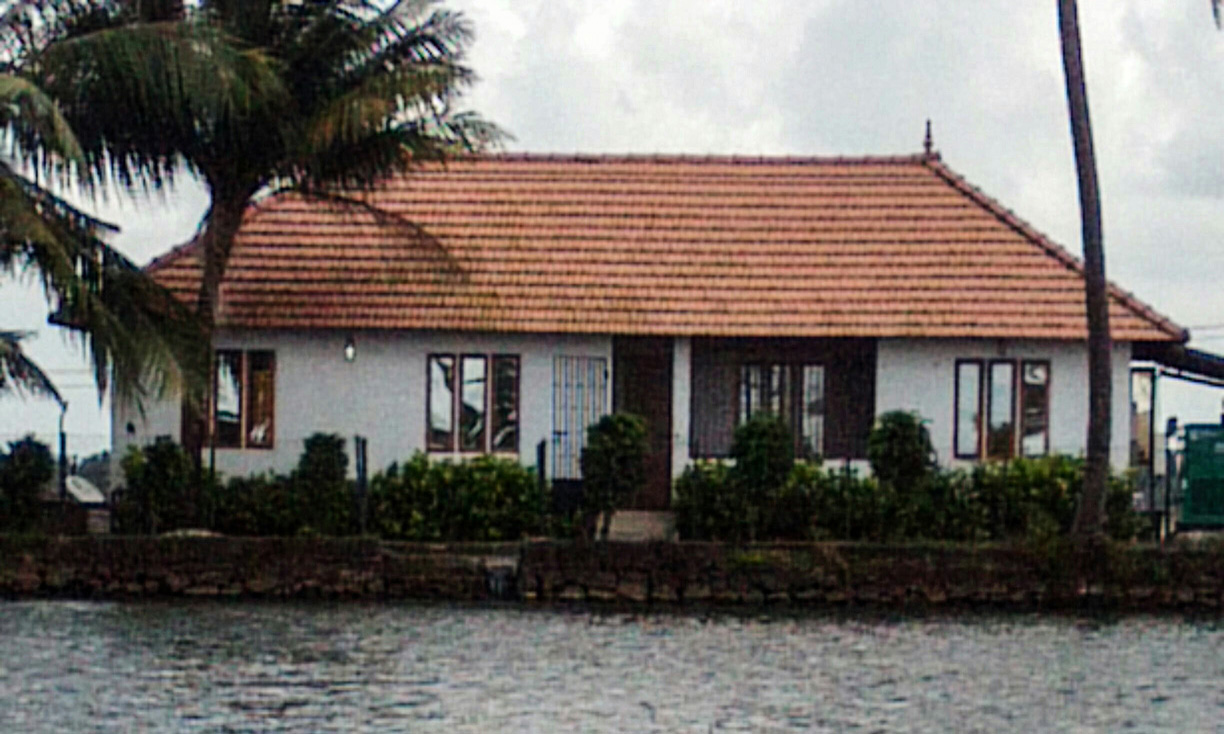
For a tourist, all this would be an attraction, but,
for locals, it might just be boring. How long can you remain
attached to a same lifestyle? Yes, surely, the lifestyle was
idyllic! Inspirational for writing! But what after the book
completes? Change is necessary! Anyways, I don't think the tourists
take the ferry too very often. So, the illusion remains intact in
the houseboats.
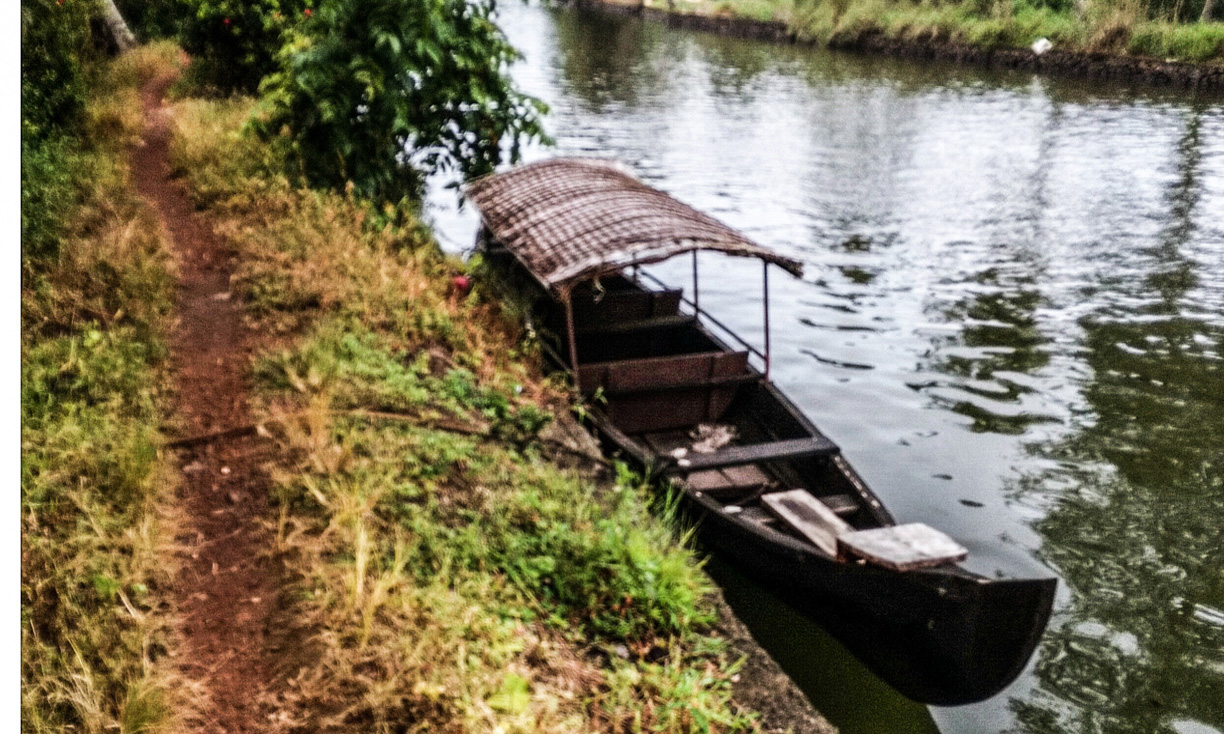
The trip in the country boat was under the smart
guidance of a local village man named James (name changed for
privacy protection), shared with three young backpackers from
Italy, Isreal and Holland. After the trip in the big size ferry,
the trip in the small country boat had its own character. The boat
was like a small activist, who would just not attach himself to the
glitz and glamour of the big houseboats. Incidentally, James was
earlier the captain of a large houseboat but had then started of
his own with that small country boat and wouldn’t change for
anything (except may be a few billions). His determination became
evident when we crossed over a large houseboat. Generally, the
small boats would halt and wait for the big motorized houseboats to
pass by, but James kept rowing. When we crossed over, it gave the
feeling as if we were rowing back along with the big houseboat, but
it was not so: we were rowing ahead with the grit and determination
of James. This was a feeling similar to what we feel when we face
big things in life. We get attracted to them so much so that we
want to follow them even if they travel in the opposite direction.
We tend to lose our direction enamored by the glamour of the big.
But if the strength of the character is maintained, we remain
focused, follow our destiny, and become important just because of
the difference we offer, which very few dare do.
After traversing the big vast stretches of Meenapalli
Lake and numerous narrow canals bordered by small and big villages,
we reached Kuttamangalam, Kainakary, a hamlet of around 3,000
people, situated on both sides of a canal of about 30 ft width. The
hamlet stretched about a km with two bridges at each corner. The
people were extremely friendly. It seemed they were living
co-operatively in a communist style living, but I also saw some
empty plastic bottles demarcating a portion of the backwaters in
front of a house, as if demarcating a private beach. Nevertheless,
the village was pretty well developed with all facilities like
roads, electricity, phone, etc, in spite of no land connection with
the main cities. There were umpteen toddy boats stationed on either
side of the canal readily available for across the canal
transportation of goods and persons in a jiffy. The Onam
celebrations had infused lots of loud dancing and singing on
incomprehensible Malayali and comprehensible Bollywood numbers on
either side of the canal. The celebrations had also created public
nuisance, including garbage and dirt, which was an exception in
Kerala.
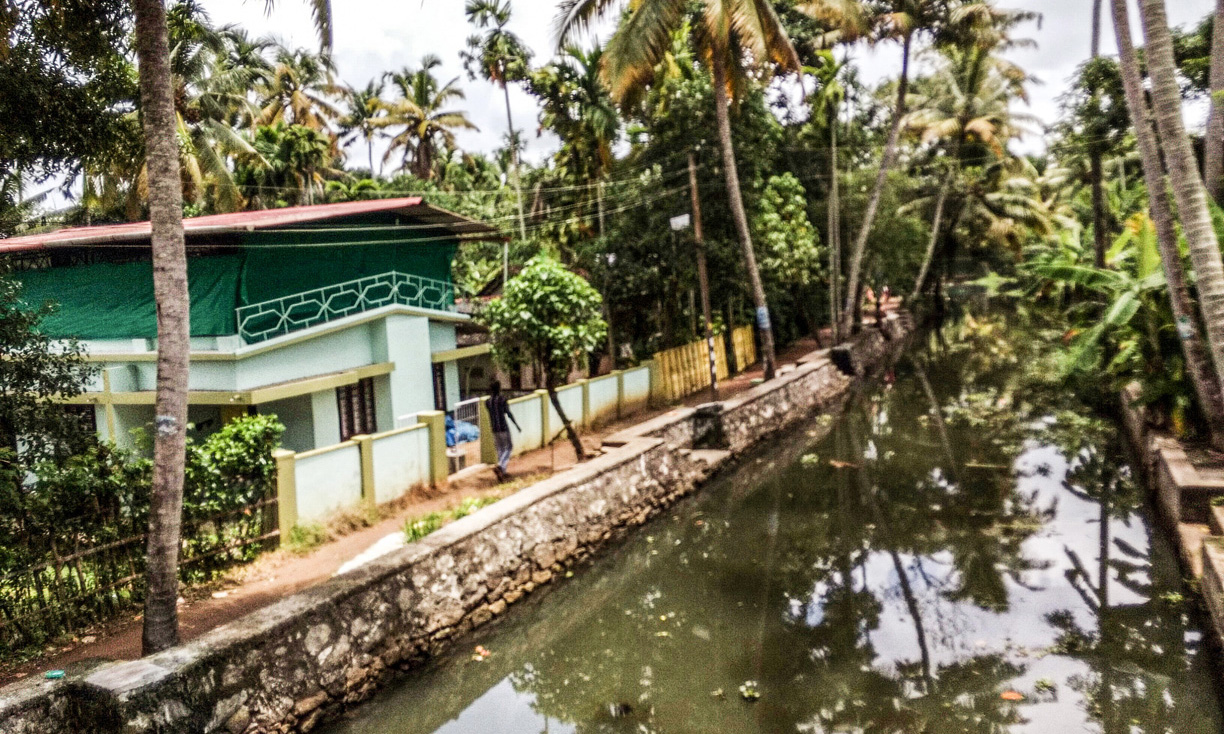
The hamlet also had a high school with SNDP name.
SNDP is a socio-religious organization, whose general secretary
seems to have recently cozied up with Amit Shah of the BJP, but
James, who was a subtle Left supporter, informed me that the people
consider SNDP a non-political outfit and don’t vote for the BJP
under any circumstance – though I doubt it; in fact, I saw lots of
BJP/RSS presence in Alleppey as well; I think, like in Bengal, the
Communists are smug in Kerala too and would get a harsh surprise
soon.
On the trip back, James was so tired that he even
allowed us to row the boat for some time, or probably he mistook me
for a teenager for the questions I had been asking him since
morning – others were anyways more or less teenagers only.
Nevertheless, I did row like a teenager for it was already
afternoon and I was indeed hungry for the promised lunch at James'.
And I was not disappointed: it was the best Keralan lunch I have
had during my trip. With this lunch, my appetite for the backwaters
was satisfied; don’t know whether the write up above has satisfied
your appetite; if not, meet me over a Lunch.
Kotayyam/Kumarakom
The small visit to Kotayyam
was completely accidental. The return ferry from Kotayyam to
Alleppey was not available for at least an hour; so, obviously I
decided to visit the city, which, as usual, was neat and clean, and
the people, friendly and helpful. The main attraction in Kottayam
district is Kumarakom backwaters. Of course, I had heard about it,
but since my objective was not luxury, Kumarakom and Kottayam were
not on my itinerary. Nevertheless, I decided to visit the bird
sanctuary in Kumarakom knowing well enough I wouldn’t spot a single
bird in a September afternoon. But what I indeed spotted was the
natural affection of the Keralites towards the tourists. They go
out of way to help you and feel embarrassed if they even
accidentally fail in their self-imposed obligation.
A small incident would make the above obvious. I took
a local bus from Kottayam to Kumarakom Bird Sanctuary, which is
some 7-8 km from the main city. In the bus, I was about to occupy a
seat when an old man jumped onto it without realizing that I was
interested in it too. But when he realized it, he kept feeling
guilty. He stood up and offered me his seat. Obviously I refused.
Finally, when I got the seat, he was delighted. Incidentally, the
seat was next to him. He kept talking to me in Malayalam throughout
the journey. I don't know Malayalam, he didn't know English, yet he
was able to communicate that the government ferry service from
Kumarakom to Muhamma was the best way to experience Vembanad Lake
at Kumarakom, and I will have to thank him because it indeed is the
best way to experience Vembanad Lake.
At the bird sanctuary, though there were no visible
birds, there was lots of chirping, which was complementing the
serene view of the lake. After a little walk, I seated myself on a
tree branch at the end corner of the canal opening into the
Vambanad Lake. The island of water hyacinths separated me from the
lake and also secured me into the protective arms of a tree fitted
tightly into the secure ground underneath. Who says water hyacinths
don’t serve any purpose! At least for me, they were my shield
against my enthusiasm, which, but for them, would have taken me to
the unknown world of Vembanad Lake, irrespective of the guard
posted for security, who in any case was napping.

I have already cribbed about the houseboats, but here
it is inevitable. The canal next to the bird sanctuary was the
boarding and alighting point for the houseboats. The houseboats
would turn at the corner where I was seated; the speed would be
lowered; the engines would exude bad diesel smell while making
obnoxious noise, which would frighten the chirping birds. I wonder
how such a thing could ever be allowed. What worse, the Kerala
Government has even categorized houseboats as Platinum, Gold and
Silver, on the revenue they earn while scaring the chirping birds.
This is Communism -- I wonder what would happen when it would be
Neo-Liberalism, which it very soon would be under the competent
advice of Gita Gopinath, the newly appointed advisor to the CM.
These houseboats may look good from far, but from near they are
nuisance, period.

Once again I was on a ferry; albeit this time on the
advice of a grounded Keralite; and what an advice it was. The ferry
traversed longitudinally through the widest stretch of Vambanad
Lake from Kumarakom to Muhamma. There was nothing but water on the
stretch. It seemed as if the water would not drown you if you were
drawn towards it; rather it promised a new life, unknown yet to
humanity. Just then I saw a toddy boat being roared by a sole soul
in the vast expanse of Vembanad Lake. Incredible! The mere thought
of riding a toddy boat on such a vast expanse of water would give
me goose bumps, but he was doing it unbothered, as if he had
already kissed the new life underneath the waters. Why and how else
can one risk his life in such a manner!

The transfer from Muhamma to Alleppey happened in a
KSRTC bus. In any other state, this would be a tiring, ordinary bus
ride. But, in Kerala, everything is an experience: even a ride in
KSRTC bus. The whole highway was lightened with shops selling
everything from plastic furniture and granite to provisions and
hardware. The habitation it seemed just didn’t end. Except for some
traffic at the Muhamma bus station junction, there were no traffic
jams anywhere. The road was pretty narrow, but everybody was
maintaining the lane discipline. There were no dividers separating
the traffic from the opposite direction, but no body was
crisscrossing to overtake vehicles. Even at the Muhamma junction,
the two policemen very swiftly released the traffic. Most
interestingly, a commoner suo-moto started helping the
policemen, which in Delhi would be madness, both for the police and
the citizenry. There, it seemed normal and necessary to exist and
survive.
Alleppey Beach
Alleppey Beach is hardly
the part of Alleppey; atleast the auto drivers gave such an
impression. It is just 4 km from the main town of Alleppey, but the
auto drivers charged anything from 60 to 150 bucks. And if you
would search for a pre-paid auto point at KSRTC, the enquiry, after
scanning you from tip to toe, would advice you to board a KSRTC bus
instead -- btw, the KSRTC bus drivers and conductors were all very
welcoming towards the tourists; so, I didn't take it negatively,
nor should you. This was the first sign of corruption I encountered
in Kerala, which continued thereafter in Haripad/Payyipad, Munnar,
Varkala, etc. Indeed, Kerala needs numerous pre-paid auto points,
for the auto trade unions there; i.e., BMS, INTUC, AITUC, etc; were
charging the Uber and Ola rates, albeit sans services even remotely
comparable.
Nevertheless, Alleppey Beach was pretty beautiful.
The beach towards the main entrance was crowded, but a small walk
towards the north direction, the beach became cleaner and quieter,
and it remained so for a very long stretch, where many beach
resorts had also come up. Interestingly, there were display boards
warning people from bathing and adventuring on that side of the
beach. I wonder whether the beach resorts or the display boards
appeared first. Anyways, the beach resorts had put up beach
furniture in front of their properties, which were then occupied by
dogs given the off season, and I must assure that the Keralan dogs,
like the Keralan men, are polite towards the tourists. They vacated
one of the benches for me, which I occupied till I enjoyed a good
afternoon nap.
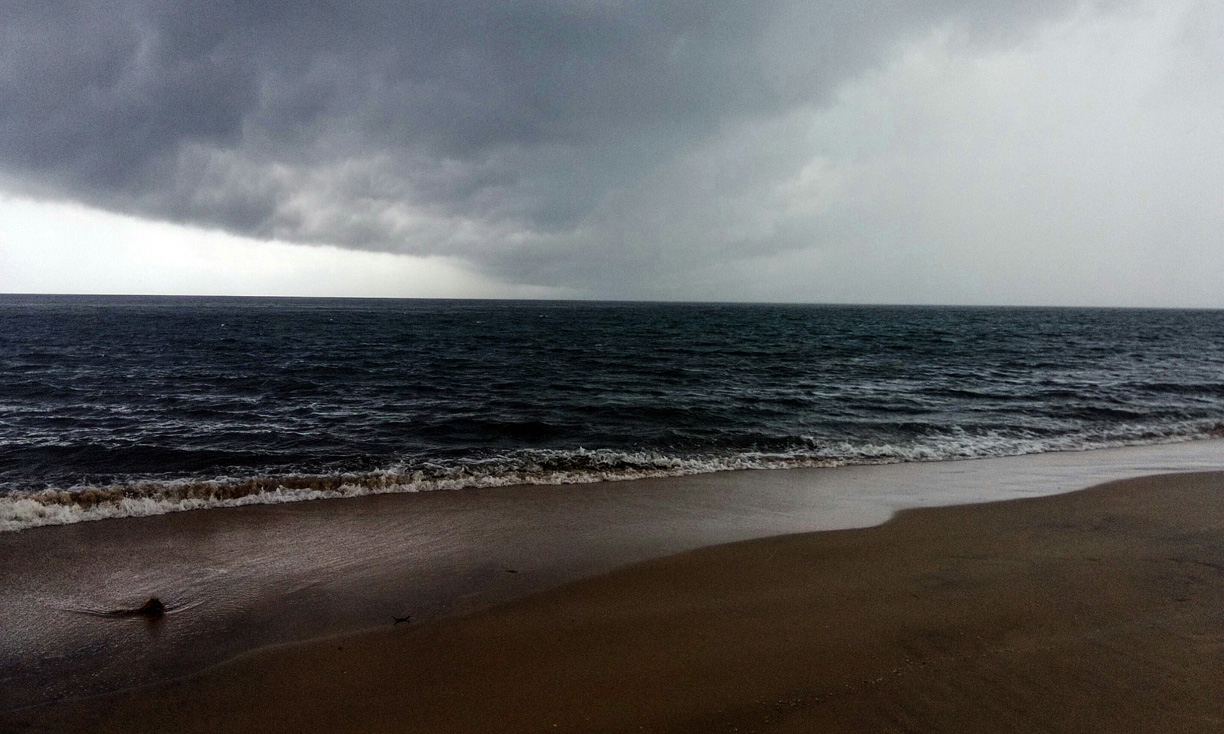
By the time I woke up, the clouds enveloped the sky
and the sea water complemented the clouds merging all into a single
whole. The rains started pouring and lot many people came over to
that side of the beach as well – Keralans are not naive after all;
they knew exactly the veracity of those warning messages. Most of
them were young college guys in some kind of a picnic mode. The
Keralites seem to be having a good diet, may be because of beef.
The young guys don't have paunches, are generally tall, and are
pretty well developed too. Also there were many older women on the
beach, who were ogling these guys, and it seemed as if it was
normal and well-accepted.
I wonder which bureaucrat in Kerala came up with the
idea of staring 14 sec or more as a criminal offence. Unless two
people stare at each other, how would one know over another who
stared whom? If a guy stares a girl, so would a girl stare the guy
to reach a conclusion that she has been stared unless Google
develops a special third eye for girls, which would capture the
stares but won’t stare the abominable guys; indeed a difficult call
even for Google. Won’t it be better to not have this staring
offence at all? Let the old women stare young guys, and let the men
stare irrespective of age, given the women never age -- anyways,
the men won't stop, certainly not at a beach!
Payyipad Boat Race
There are lots of snake boat
races in Kerala, especially during the Onam festival celebrations.
The biggest of them all, Nehru Trophy, was already over, but there
were many challengers for the second spot: Payyipad, Aranmula,
Moolam, etc. I chose Payyipad for no specific reason. This race is
patronized by the Congress’ politicians, and it did turn pretty
funny by the end of it. Let me give the spoilers right away.
The participating captains would fight over lane
selection, and the forthwith commentator would also apprise the
audience of it. The audience, so patient, would wait for an hour
for the captains to settle the dispute. As a compromise, all of
them would race in the single central lane, and since they would
ride so close to each other, nobody would win or lose but one would
be announced winner nevertheless. The winner would obviously do a
victory parade, in which the losing team's supporters would throw
pop corns, water, ice cream, bottles, shoes, sticks, chairs,
banners, furniture, and almost everything else available to them at
their disposal in the VIP enclosure.
Nevertheless, the event was not so poorly organized
even. There were three enclosures for seating the audience,
ticketed at Rs 150/-, Rs 250/- and Rs 500/-. I chose the Rs 250/-
enclosure, and thankfully so given what would eventually happen in
the VIP enclosure ticketed at Rs 500/-. The Rs 150/- enclosure was
occupied mostly by the police personnel. Or, were they given free
passes for crowd control? Whatever, they became part of the crowd,
more or less, and didn't do anything to control the crowd. And
thankfully so, else the event wouldn't have ended so
entertainingly.
But the enclosures were superfluous. The best vantage
points were available on tree branches, canal embankments, bridge
pillars, and anywhere and everywhere in the canal generally but
only if you were willing to swim with or without clothes. I did
take a plunge, left my comfortable seat, and seated myself on the
canal embankment in front of the enclosure, which did give me a
very advantageous vantage point, albeit with a constant threat of
being dropped into the canal by an ever enthusiastic crowd.
Anyways, in the enclosure, my seat was next to a drunken old man,
who would soon tear off all his clothes and jump into the
canal.
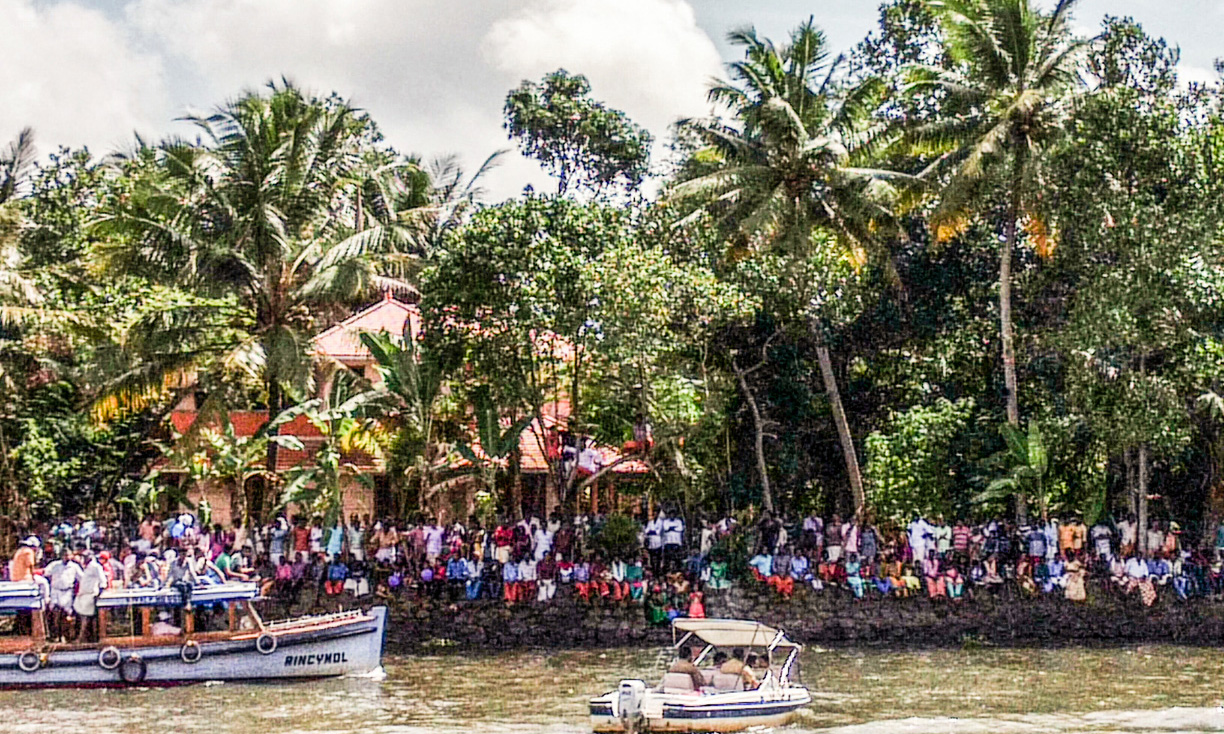
BTW, there was a family of three foreigners too in
the audience (no, not Italians), who were also seated in the same
enclosure and were garnering lots of eyeballs. The mother was an
effusive lady, who was looking younger than her age, and the
Kerelan guys were waving at her continuously from the many boats
they were riding in the canal before the race, and she also seemed
to be enjoying the attention. I don’t know what happened to her by
the end of the race. I only hope she didn’t enter the VIP enclosure
for security.
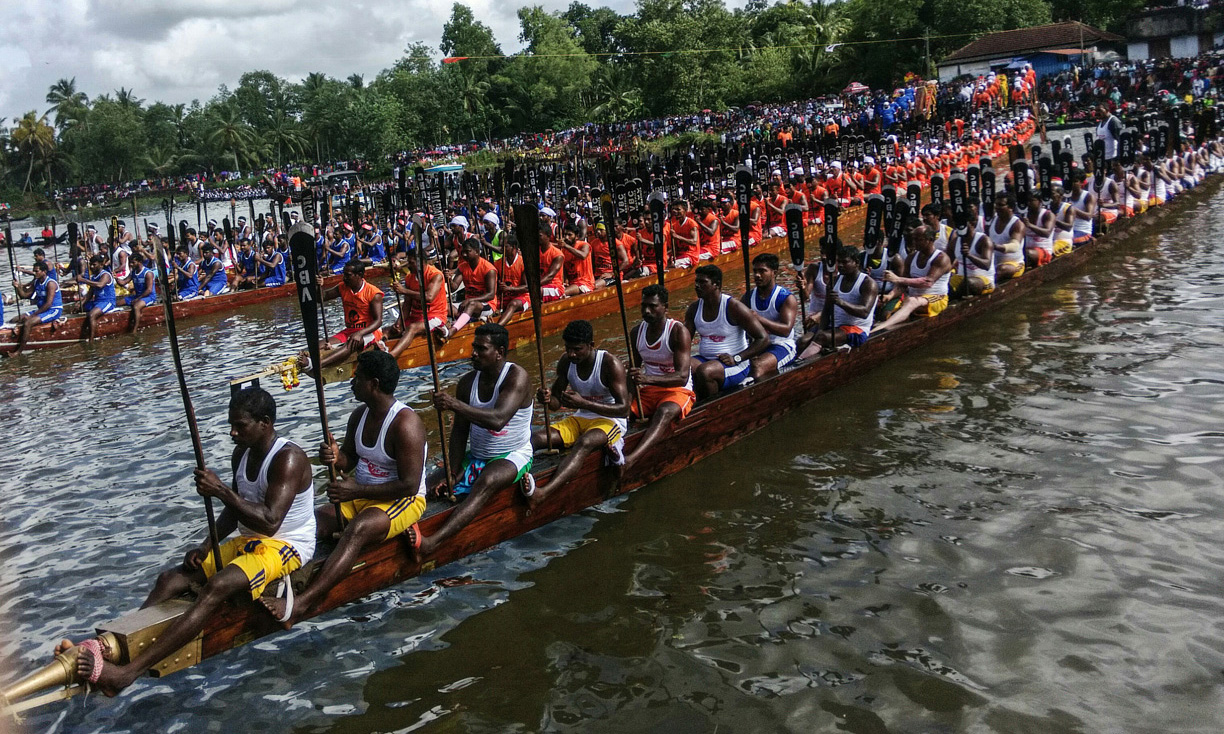
The real race was preceded by a random boat parade,
which included participants from Baba Ramdev’s Patanjali Centre,
Nuns from the local church, some Muslim clerics, professional
dancers, a circus troupe, et al. However, the real
participants were very well organized, who presented a fantastic
drill near the finishing line just before starting the races, and
that’s the only time I felt happy on spending money to watch the
race because then the canal was cleared of all boats and swimmers
and the drill was the only distraction in the water, which was best
visible to the privileged ticket holders.
The races continued for almost two hours with
continuous commentary in Malayalam by an energetic speaker. I made
friends with two Malayalam speaking locals, who religiously updated
me with the happenings. However, even they were confused. I ended
up watching at least five final races till I found the finalists
were actually fighting over lane selection as discussed above. The
others were actually self-sponsored races of the losers, who were
trying to win, if nothing else, the appreciation of the
audience.
Eventually, when the final race did happen, it was
electric. There was not a single soul seated on the seats. People
were clapping, singing, and shouting continuously, and those high
on adrenalin were jumping into the water with or without clothes.
This was an event which can’t be described but can only be
experienced. I think this boat race would be better than the more
sophisticated Nehru Trophy Race because of the liberty it gave to
the audience to become the participants. No wonder, when the stakes
were so high, some people would get offended and throw pop corns,
water, ice cream, bottles, shoes, sticks, chairs, banners,
furniture, etc, into the victory parade. I don’t think this
electric an environment could have ended in any other manner. All
in the game!














